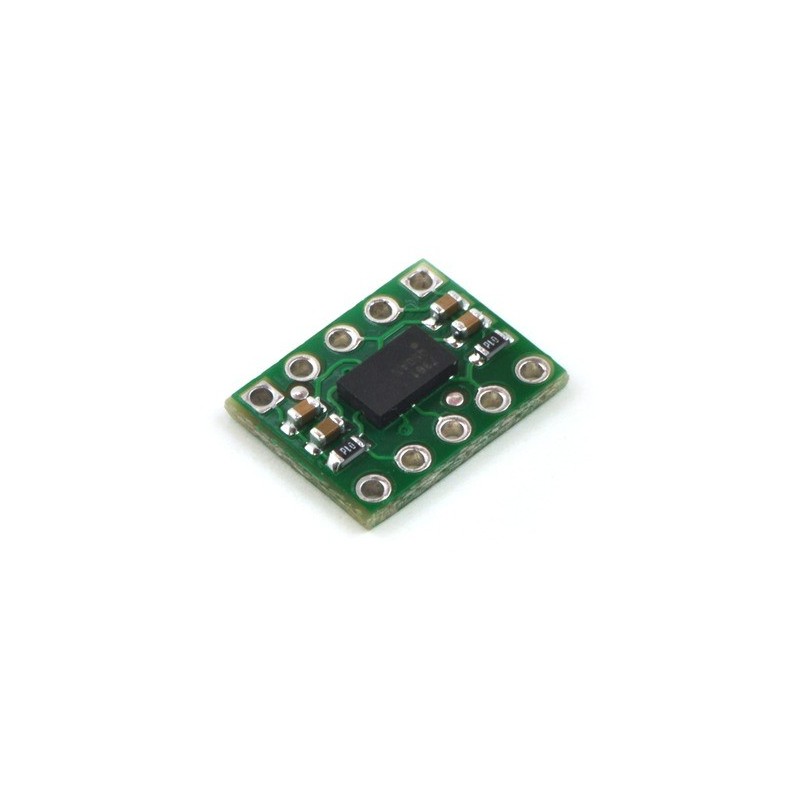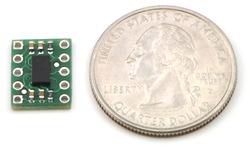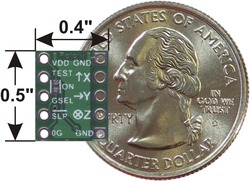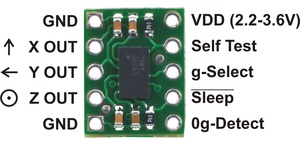- Obecnie brak na stanie

MMA7361L 3-Axis Accelerometer ±1.5/6g
This tiny triple-axis accelerometer is a basic carrier board for the Freescale MMA7361L XYZ-axis accelerometer, a great low-g sensor with analog voltage outputs, adjustable sensitivity (±1.5 g or ±6 g), and a 0g-detect digital output that signals when the board is in free-fall. Our breakout board has the form factor of a 10-pin DIP package, which makes it easy to use with standard solderless breadboards and 0.1" perfboards, and the unit is smaller than competing products, all at a lower price. The board operates from 2.2 to 3.6 V.
Note: The MMA7361L and MMA7341L ICs on these boards have been replaced by the newer MMA7361LC and MMA7341LC, respectively. The only functional differences are a slight change to the tolerance of the zero-g Z output (both MMA7361LC and MMA7341LC) and change in the magnitude of the z-axis self-test response (MMA7341LC only).
 |
This tiny three-axis accelerometer is a breakout board for Freescale’s MMA7361L (192k pdf) and MMA7341L (195k pdf) MEMS (micro-electro-mechanical systems) low-g accelerometers; we therefore recommend careful reading the appropriate datasheet for your particular board before using this product. The MMA7361 and MMA7341 are great ICs, but their small, leadless packages makes them difficult for the typical student or hobbyist to use. This carrier board includes all of the components in the part’s recommended connection diagram and breaks the pins out to a 0.5"×0.4" (12.7×10.2 mm) 10-pin DIP form factor that is easy to use with standard solderless breadboards and 0.1" perfboards.
The two versions of this board provide different sensitivity options: the MMA7361L carrier offers selectable ±1.5g or ±6g sensitivities and the MMA7341L carrier offers selectable ±3g or ±11g sensitivities. We also sell two larger versions of this carrier board that include a 3.3V voltage regulator: the MMA7361L 3-axis accelerometer carrier with voltage regulator and the MMA7341L 3-axis accelerometer carrier with voltage regulator
 |
 |
The board is powered by supplying 2.2 to 3.6 V on the VDD pin. Note that this part does not have 5V-tolerant pins, so external components (such as voltage dividers) are required when interfacing the board’s g-Select, Self Test, and Sleep pins with 5V systems. Connections to these pins are optional; the board will work with these pins disconnected as long as the sleep pin is driven high with an on-board solder bridge as described below.
The sleep pin, Sleep, is internally pulled low, which puts the board into low-power sleep mode by default. You must drive this pin high to use the board. This can be accomplished with a microcontroller I/O line if you want selective control of sleep mode, or you can make a solder bridge across the SMT jumper pads labeled “ON” on the silkscreen side of the board to connect the sleep pin to VDD and enable the board by default.
The accelerometer X, Y, and Z outputs are three separate analog voltages centered at VDD/2. Positive accelerations along an axis increase that axis’s output voltage above VDD/2 and negative accelerations decrease the output voltage below VDD/2. The outputs will always be within the range of 0 to VDD.
The sensitivity selection pin, g-Select, is internally pulled low, which selects for a default sensitivity of ±1.5g (800 mV/g) on the MMA7361L carrier and ±3g (440 mV/g) on the MMA7341L carrier. Driving the pin high selects for a sensitivity of ±6g (206 mV/g) on the MMA7361L carrier and ±11g (118 mV/g) on the MMA7341L carrier.
The 0g-Detect pin outputs high when all three axes simultaneously detect 0g, which happens when the board is in free-fall. This pin is only documented in the datasheet of the more sensitive MMA7361L IC (the MMA7341L datasheet labels this pin as “NC”), but we have found that it works on the MMA7341L at its default ±3g sensitivity. This output does not work at the ±11g sensitivity setting.
The Self Test pin is pulled low on the board and can be left disconnected.
A 10×1 strip of 0.1" header pins is included, as shown in the left picture below. These pins are not pre-installed. You can break the strip into two 5×1 sub-strips and solder them in to make a 10-pin DIP that can easily be used with solderless breadboards or 0.1" perfboards, or you can solder wires directly to the board for more compact installations. The right picture below shows the two possible board orientations when used as a 10-pin DIP (parts visible or silkscreen visible).
|
|
 |
MMA7341L 3-Axis Accelerometer ±3/11g |
 |
LPY510AL Dual-Axis (Pitch and Yaw or XZ) Gyro with ±100°/s and ±400°/s Ranges |
 |
0.100" (2.54 mm) Breakaway Male Header: 1x40-Pin, Straight |
Producent BTC Korporacja sp. z o. o. Lwowska 5 05-120 Legionowo Polska sprzedaz@kamami.pl 22 767 36 20
Osoba odpowiedzialna BTC Korporacja sp. z o. o. Lwowska 5 05-120 Legionowo Polska sprzedaz@kamami.pl 22 767 36 20
Brak towaru
Wyświetlacz graficzny 240x128 pikseli, 144x104mm, podświetlanie LED (WHITE) POSITIVE, kontroler T6963C/SAP1024B, wbudowany generator znaków
Brak towaru
Brak towaru
Zestaw AVT do samodzielnego montażu solarnej ładowarki akumulatora 12V. AVT5598 B
Brak towaru
Brak towaru
Płytka ZYBO Z7 (Zynq Board) to odnowiona wersja zestawu zawierającego układ programowalny z rodziny Xilinx Zynq-7000 - Z-7010. W zestawie także Voucher Xilinx Zynq SDSoC. Digilent 471-014
Brak towaru
Brak towaru
MAŁA AUTOMATYKA DO WZMACNIACZA LAMPOWEGO - PŁYTKA DRUKOWANA I ZAPROGRAMOWANY UKŁAD
Brak towaru
Zestaw modułów POD dedykowanych dla Raspberry Pi Zero i Zero 2W. Zawiera obudowę Zero POD Case oraz moduł ekspandera USB i HDMI. Waveshare Zero POD HDMI USB HUB Module KIT
Brak towaru
Wyświetlacz 7-segmentowy LED, 1 cyfra 13,20mm, kolor zielony (575nm), 5 mcd (10mA), wspólna anoda, kolor czerwony (630nm), 6 mcd (10mA), wspólna anoda. Pb-free. LED1-AS-05211BMRMG-B
Brak towaru
ATmega8515-16JU to mikrokontroler z rodziny AVR w obudowie PLCC44, wyposażony jest w pamięci: 8 kB Flash, 512 kB SRAM,512 B EEPROM. Dodatkowe wyposażenie to: interfejs UART oraz interfejs SPI. Napięcie zasilania to 2.7 ..5.5 V, maksymalne taktowanie 16 MHz.
Brak towaru
Thermopad, taśma termoprzewodząca dwustronnie przylepna 20mm x 130mm x 1mm, 2,4W/mK, AG Termopasty, RoHS
Brak towaru
Magnetometr Explore umożliwia pomiar pola magnetycznego w trzech płaszczyznach XYZ, wyposażony w cyfrowy czujnik MAG3110. MOD-64
Brak towaru
Brak towaru
Przewód dwużyłowy o długości 150mm zakończony wtykiem oraz gniazdem JST XH2.5. Średnica przewodu 22AWG.
Brak towaru
Gigabit-PoE-Switch-120W to wydajny i cichy przełącznik sieciowy z funkcją zasilania przez Ethernet, idealny do systemów monitoringu IP, instalacji z Raspberry Pi 5 i innymi urządzeniami zasilanymi przez PoE. Dzięki obsłudze pełnego dupleksu, mechanizmowi priorytetu i pasywnemu chłodzeniu, sprawdzi się zarówno w zastosowaniach domowych, jak i przemysłowych, oferując stabilną transmisję danych i zasilanie w jednym kablu.
Brak towaru

MMA7361L 3-Axis Accelerometer ±1.5/6g
